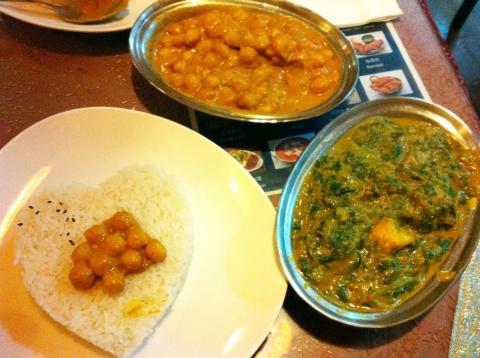It might be easy to overlook Masala House (異香料館), which is located among a cluster of student eateries and cafes near Shida Road (師大路). Out of India, a nearby popular Indian restaurant, looks like it attracts more foot traffic by virtue of its location at the entrance of the alley on Pucheng Street (浦城街) where both restaurants are located. But Masala House, which offers a few unique items on its menu, is worth a visit.
On my first visit, I ordered the chana masala (NT$250), a spicy dish of chick peas, and palak paneer (NT$250), a spinach curry with chunks of paneer cheese. Both were delicious. If you’re wary of spicy foods, though, be aware that both curries had a fiery kick even after a request for less spicy versions.
These dishes come with a serving of white rice shaped in a heart on your plate. Naan bread is also available for an additional NT$40 (NT$50 for garlic or butter flavored) and roti is NT$50.

Photo: David Chen, Taipei Times
The curries had already won me over, but what sealed my decision to return for a second trip was one of the restaurant’s south Indian specialties, its dosa, a large crepe made of rice flour and lentils. A dosa, which costs NT$50, is a crispy version of a crepe and makes for a nice alternative to naan bread. It’s also available with a garlic or butter for NT$60.
The dosas go especially well with Masala House’s green chutney (NT$35), a sauce made of chopped cilantro and garlic, or another south Indian dish called sambar (NT$100), a sweet-and-sour stew of green beans and cauliflower. These items also come as accompaniment for the masala dosa (NT$150), which is a dosa rolled up and stuffed with potato curry. This makes for a satisfying lunch if you’re in the mood for something other than curry and rice.
I would have tried another south Indian dish, idli (NT$80), a savory cake that’s also made of rice and lentils, but the restaurant wasn’t serving it on my last visit. Maybe next time, if I can resist not ordering the masala dosa again.
As for classic Indian dishes, Masala House offers a large menu, with around a dozen varieties each for beef, chicken and vegetarian dishes. Prices are average, ranging from NT$230 to NT$300 per dish. Tandoori grilled chicken is available for NT$250 a serving and NT$550 for a whole chicken, which needs to be ordered in advance.
In a nod to its student clientele, the restaurant offers a price-busting selection of curry and rice lunch specials: vegetable, daal and chicken curries are NT$100 each, mutton is NT$150, and beef is NT$130. The lunch comes with rice and a soda, and the rice can be replaced with naan for an additional NT$20.
The atmosphere at Masala House is cozy, with the kind of decor one expects at an Indian restaurant in Taipei, and Bollywood music videos playing. The cafe-sized space looks a little run down — you can see peeling wallpaper in the corners of the room — but the food makes up for this shortcoming.

In the March 9 edition of the Taipei Times a piece by Ninon Godefroy ran with the headine “The quiet, gentle rhythm of Taiwan.” It started with the line “Taiwan is a small, humble place. There is no Eiffel Tower, no pyramids — no singular attraction that draws the world’s attention.” I laughed out loud at that. This was out of no disrespect for the author or the piece, which made some interesting analogies and good points about how both Din Tai Fung’s and Taiwan Semiconductor Manufacturing Co’s (TSMC, 台積電) meticulous attention to detail and quality are not quite up to

April 21 to April 27 Hsieh Er’s (謝娥) political fortunes were rising fast after she got out of jail and joined the Chinese Nationalist Party (KMT) in December 1945. Not only did she hold key positions in various committees, she was elected the only woman on the Taipei City Council and headed to Nanjing in 1946 as the sole Taiwanese female representative to the National Constituent Assembly. With the support of first lady Soong May-ling (宋美齡), she started the Taipei Women’s Association and Taiwan Provincial Women’s Association, where she

Chinese Nationalist Party (KMT) Chairman Eric Chu (朱立倫) hatched a bold plan to charge forward and seize the initiative when he held a protest in front of the Taipei City Prosecutors’ Office. Though risky, because illegal, its success would help tackle at least six problems facing both himself and the KMT. What he did not see coming was Taipei Mayor Chiang Wan-an (將萬安) tripping him up out of the gate. In spite of Chu being the most consequential and successful KMT chairman since the early 2010s — arguably saving the party from financial ruin and restoring its electoral viability —

It is one of the more remarkable facts of Taiwan history that it was never occupied or claimed by any of the numerous kingdoms of southern China — Han or otherwise — that lay just across the water from it. None of their brilliant ministers ever discovered that Taiwan was a “core interest” of the state whose annexation was “inevitable.” As Paul Kua notes in an excellent monograph laying out how the Portuguese gave Taiwan the name “Formosa,” the first Europeans to express an interest in occupying Taiwan were the Spanish. Tonio Andrade in his seminal work, How Taiwan Became Chinese,